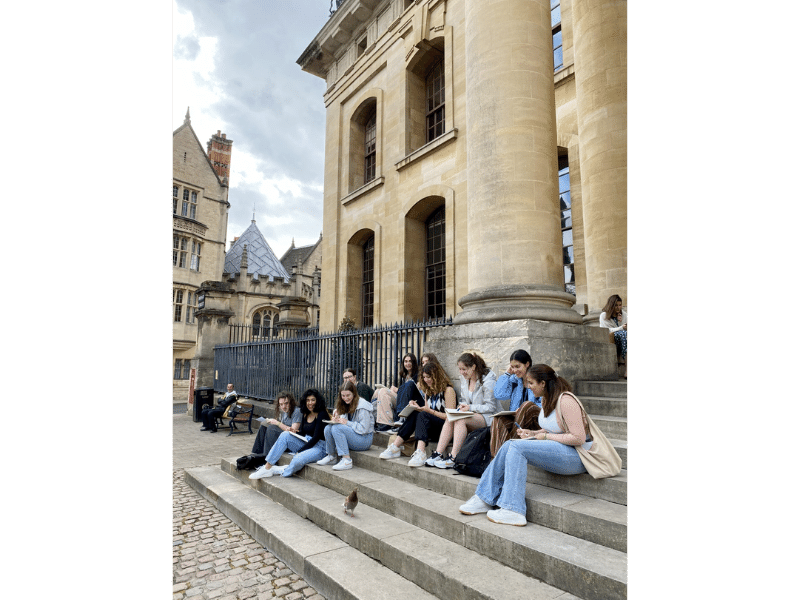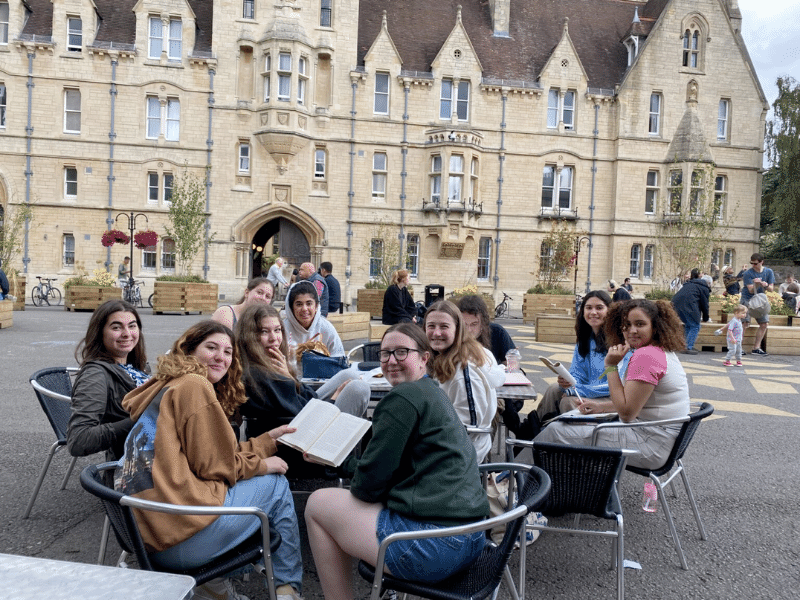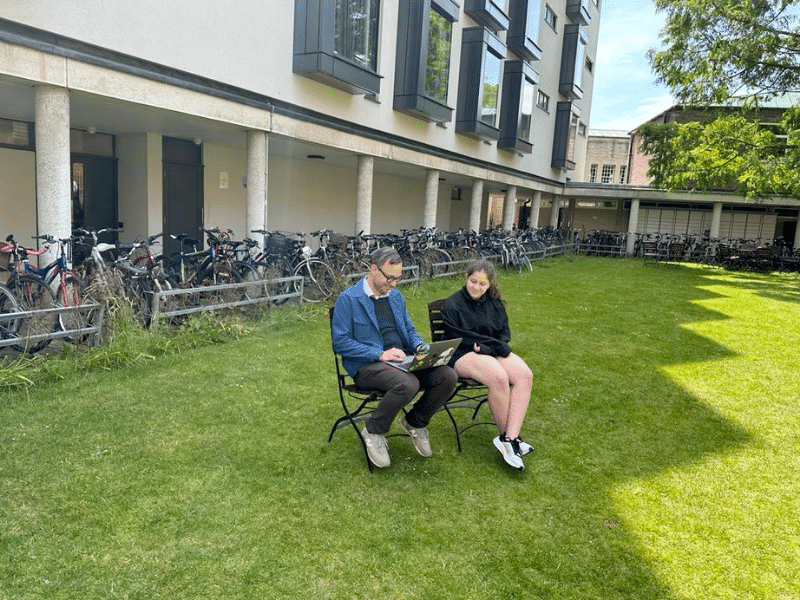Our Oxford Academia Creative Writing majors gathered inspiration from the environment around them and rarely stayed in the classroom. Here is a blog post from the leaders and students on the Creative Writing program at Oxford over the summer of 2023.

It was a cool summer, and we spent the time hiding from a light drizzle in a room overlooking the Radcliffe Quad of University college or sitting underneath the shadow of the great swamp cypress on the Goodhart Lawns. We wandered through the city streets, guided by the writings of old Oxonians, or trailing unsuspecting townspeople and tourists, searching everywhere for inspiration to write.
Here are excerpts from the work of our Creative Writing majors:
Nina G.
Monday. July 10th. 4:08pm. Inside the University college common room. Tensions are high. The question in debate: Is Taylor Swift a robot? The room is in a state of chaos, split into two sides: Taylor Swift is human vs. Taylor Swift is a robot. Teenagers are screaming in all directions, each trying to back up their own argument. None of them are successful. The psychology and artificial intelligence professor stares at the room in horror. What has he started?
He makes a rule that all students must raise their hands before they speak, only after having to threaten to kick out students who continue to yell, and he is determined to enforce it. Once the room is mostly settled, he poses his question again: “How do we know that Taylor Swift is not a robot?” Then, a student raises her hand and asks a very different question: “Why should we care?”
Yes, there is evidence that supports the humanity of Taylor swift, but will it ever be known for sure? She could be a microchip in a human body. She could have originally been human, and then replaced with AI by some anonymous power. This argument can essentially be made for any “human.”
The scary truth is that AI is a constantly developing power and there is no real way of knowing how advanced AI is now. Some students argued that AI has not been developed enough in the past, so it’s not possible for Taylor Swift to have been AI for her whole life. But how do we know that?
For hundreds of years, students just like this group have gathered in this very room and had thousands of other debates. Though over the years the furniture and decorations have been replaced and changed many times, the room always had the same purpose. The plaster walls have overheard tons of conversations just like this one. Over the years the topic of discussion has changed and evolved, but Oxford will always be a host for questions, debates, and inquiry. Oxford will always be a place of learning.

Chloe L.
The Book of Bodleian
On Sunday, July 2nd my 12 hour journey from a casual southern California high school brought me to one of the oldest educational institutions in the Western World. On a walking tour of Oxford’s ancient cobblestone streets and time-worn walls, professor Basker herded us into the grand Bodleian Library courtyard. Looming above the hub of academic research, a stone statue of James I of England sat atop the The Tower of the Five Orders. Resting regally, he stretched out two hands to the students, each offering a weighty tome filled with knowledge. Gazing up at the granite giant, I listened to the tour guide explain how it was built by the university in an attempt to flatter the king and secure monarchical donations. An intuitive inkling burned through my head, telling me something was off. The King James I portrayed in the sculpture was a uniter of nations and a generous supporter of arts, academics, and the betterment of the British people. But written in Oxford’s rock is both propaganda and historical truth. Our explorations of this city acted as a paint remover, peeling back the surface layers to expose the true stories that lie underneath. I was now a detective in the fashion of Bogart or Nicholson; the only differences being that my trench coat was a bomber jacket and my fedora was a faded black baseball cap. Instead of a magnifying glass and a gun, I had memories from my AP European History class. Sleuthing around in the facts floating in my mind allowed me to deduce the following:
James the Peacemaker would leave behind a legacy of bloodshed and civil turmoil. While the protestant ruler strived for religious unity, his devotion to the Divine Right of Kings and the absolute authority of the Church of England would create a destructive dichotomy between Parliament and the throne. Division between constitutional monarchists and royalists, as well as between different religious sects, set the stage for the bloody English Civil War that lasted more than thirty years. Ironically, the same leader that led to this gruesome period of death and national division, also dreamed of a unified England, commissioned the first translation of the people’s bible, and created one of the most culturally influential western texts.
Thus, the history carved into the architecture of this intellectual mecca contains truth, lies, and complexity. This library that has seen 421 years of stories, has been an audience to the tragedies, comedies, and histories of the years. On Sunday, July 2nd, I stood on the very stage where some of the greatest historical figures performed tales of Shakespearean proportions. Like with Shakespeare, reading the history of Oxford has introduced me to a cast of multi-layered characters, each with their own secrets that we can attempt to interpret. However, as much as I will attempt to analyze the book of the Bodleian, the complete picture of the past will forever remain a mystery.

Jojo T.
The Power of a Painting
I stand upon the endless paintings and sculptures that hang on the walls of the Ashmolean Museum in Oxford. Panels of Sleeping Beauty and busts of birds and humans alike create a labyrinth of art and beauty that leave me separated from my tour guide. I am suddenly stopped in my tracks: A brightly-colored natural scene has caught my attention, but I soon see that what the painting depicts is not all it seems. Closer inspection shows me that the boy I had first seen is not sleeping, but mourning. It is Arthur Hughes’ “Home From Sea,” and it is bringing me to tears in the middle of the museum.
Initially titled “A Mothers Grave” at its first exhibition in 1857, the scene depicts exactly that: a boy, dressed in naval uniform, lies on his stomach in front of what is presumed to be the grave marker of his mother, who must have died while he was away. His hands are clasped, and he seems to be praying, his hat and nap sack nearby. A girl sits next to him in a composed yet disturbing grief. The girl was posed for by painter Hughes’ daughter, Tryphena, and was added later following criticism of the original painting. Although the artist relented, making changes to the boy as well as adding the girl, he is still able to convey powerful emotions through the painting.
The loss is further exemplified through symbolism, like the dew-covered spiderwebs and dandelion seeds. However, what brings the final blow are the animals in the background. A mother lamb cries desperately for its child, who is hidden behind a gravestone. The pain and panic of the mother sheep make one think about the experience the children are going through, being separated from their parent by mortality.
The saturated colors, flowers, and sunlit church seem to make the scene more depressing compared to if it was painted in melancholic colors. That life has gone on, even while the boy was away at sea, and it continues to while the children mourn.
The painting, which was exhibited again in 1863 at the Royal Academy with its final title, “Home From Sea,” lies in front of me. As I leave the museum, still thinking of this painting, I reach out to my mother, whom I have barely messaged all week, and tell her that I love her.
Natalie S.
“You can’t step on the lawn.” The porter was tall and skinny, and looked just as sleep-deprived as I felt. His voice was tinny yet cold.
The first rule I learned when I arrived at Oxford for my summer program, from a teacher who was much too spry for my sleep-deprived brain. I nodded absentmindedly, deciding to focus on my Bob Dylan playlist and not the droning voice of the counselor. As my days on campus passed, it became clearer and clearer that the lawn was a prized possession of the professors and staff; a symbol for Oxford’s extensive history. After all, Oxford is the second oldest university in the world. Students have received their education within these walls and on these grounds for over nine-hundred years. But what is the lawn rule all about? Why is the grass that lines the buildings so important to the school’s history? I soon learned, after accidentally skimming the side of the lawn many times, that it’s all about tradition. Very few Oxford campuses allow students and staff to walk on the grass. The rules vary depending on the school. This is because, ever since the beginning, clean lawns and pristine architecture have represented Oxford’s past. In modern times, keeping a lawn is much easier than it was nine-hundred years ago. Maintaining the grass is a sign of respect to those who came before us, who kept the lawns as they are now, with much more effort than is required.
Of course, the lawns that students are permitted to step on are just as beautiful as the unscathed ones, as they are mowed and cared for frequently. Still, the tradition of Oxford’s untouched lawns is important to the people close to the University. Although I have to extend my walk by a few seconds when I wish to exit the campus, I feel like I’m a part of an inside joke every time I avoid the green.

Gigi L.
I walked down the street. The cobblestones hurt my feet. It was sunny. I have never been to Oxford before, and I never understood the history until now, when I went on a tour of the town. The university is large and sporadic – there are thirty different colleges with thirty different campuses, each with its own story. I learned about the gardens at christ church college, and how they were used as a hospital during the world wars. I learned about Rhodes, his donations, and his problematic history. I learned about an old mailbox that has been in use for hundreds of years and still works today. As I walked through these colleges, I also noticed the flyers for different societies and tutoring services, student organizations and teacher office hours. The disposition of the history and the modern college was jarring, but also made me think. Historical artifacts are typically things we look at, but do not use – like the ruins of Athens and Rome. But at this University the historical artifacts are still being used for their original purpose; learning.

Estefany F.
University College
Stepping off the Bus at Oxford University for the first time was like nothing I had ever experienced. Grabbing my luggage, I followed the crowd into University College taking in everything I was seeing. It was as if I was in a movie. Everything from the Ivy on the old decaying walls to the beautiful green grass was magical. I made my line and proceeded to check in, two nice people handed me my folder and asked if I had any medication. It was somewhat hard to concentrate on one thing, everything caught my attention. From the flowers on the vines and the chirping of the birds to the sweet smell of the earthy grass as I walked past the lawn through the path. I felt like I was at Hogwarts. At that moment, I was the luckiest girl in the world for being given the opportunity to be there. Standing awkwardly, a tall, blonde man with a black bookbag began walking toward me. He was smiling. His smile brought comfort to me and made me feel as if I belonged there. That was the first smile I had gotten. Somewhere in the mists of our small talk, he states that University College was the oldest college in Oxford. I didn’t believe him at first, but taking a good look around me he was right. The cracks in the walls and the small hidden details around the building confirmed it. No architect nowadays would think of doing such a thing.
University College was founded in 1249 by William of Durham and claims that it is the oldest college in Oxford University. However, Balliol and Merton Colleges additionally claim that they are the oldest colleges at Oxford University. Not every building from the Universities is as they were before. They would not have survived the almost 800 years of teaching. Every single building had to be modified and extended to fit the needs of the period. University College, for example, has buildings that have been built in the 1600s with architectural designs mainly stemming from Gothic and Baroque architecture designs. Many of the most interesting buildings are a conflation of the two styles. Because of this, we may never truly know who was the first-ever college at Oxford University. However, I will always remember how stepping into the old buildings of University College made me feel like I was transported into another Universe.

Abby S.
As the tall crowded bus huffed to a stop, we stepped off into a new world. The grey cobblestone streets wound aimlessly every which way; it was easy to get lost in the need to explore. Stratford upon Avon displayed old quaint buildings that embodied the feeling of home. Welcomeness was emanating off of every corner, pulling us further in. There was a glistening body of water flowing through the town and lining it was a big white Ferris wheel. Dogs roamed free from their owners, never straying too far; they were happy. Young kids ran around an open patch of bright green grass, giggling as their big fluffy dog chased them in circles. Smiles were plastered across the faces of families walking along the side of the river. The sound of nature surrounded us wherever we went. Birds were singing and leaves were rustling. Not too crowded, the scene was perfect for a family. William Shakespeare was born and raised in this special place. Educated there, he was connected to Stratford as part of his family. Even in the years he left for London, his family was stationed at his home, waiting for him. When he was ready to pass, he made sure it was in the town he loved.
Click here to learn more about our Oxford Academia Creative Writing seminar.
